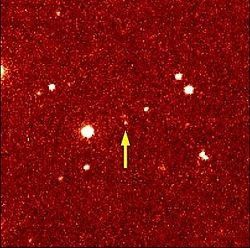Promethius20 (talk | contribs) (Adding categories) Tag: categoryselect |
Promethius20 (talk | contribs) No edit summary Tag: rte-wysiwyg |
||
| Line 1: | Line 1: | ||
| − | 90377 Sedna is a [http://en.wikipedia.org/wiki/Trans-Neptunian_object <u>trans-Neptunian object</u>] discovered in 2003, which currently lies about three times as far from the Sun as [ |
+ | 90377 Sedna is a [http://en.wikipedia.org/wiki/Trans-Neptunian_object <u>trans-Neptunian object</u>] discovered in 2003, which currently lies about three times as far from the Sun as [[Neptune]]. [[File:250px-NASA_Sedna.jpg|thumb|250px|A picture of Sedna]] |
==Characteristics== |
==Characteristics== |
||
| − | Roughly two-thirds the size of [ |
+ | Roughly two-thirds the size of [[Pluto]], Sedna is theoretically large enough to be rounded by its own gravity, and thus would qualify as a dwarf planet under current definitions. However, its distance from the Sun makes determining its shape difficult. Spectroscopy has revealed that Sedna's surface composition is similar to that of some other trans-Neptunian objects, being largely a mixture of water, methane and solid nitrogen with [http://en.wikipedia.org/wiki/Tholin <u>tholins</u>]. |
[[Category:Planets]] |
[[Category:Planets]] |
||
| − | [[Category:Dwarf Planets]] |
||
[[Category:Locations]] |
[[Category:Locations]] |
||
[[Category:Dwarf Planet]] |
[[Category:Dwarf Planet]] |
||
Revision as of 03:50, 30 November 2015
90377 Sedna is a trans-Neptunian object discovered in 2003, which currently lies about three times as far from the Sun as Neptune.

A picture of Sedna
Characteristics
Roughly two-thirds the size of Pluto, Sedna is theoretically large enough to be rounded by its own gravity, and thus would qualify as a dwarf planet under current definitions. However, its distance from the Sun makes determining its shape difficult. Spectroscopy has revealed that Sedna's surface composition is similar to that of some other trans-Neptunian objects, being largely a mixture of water, methane and solid nitrogen with tholins.